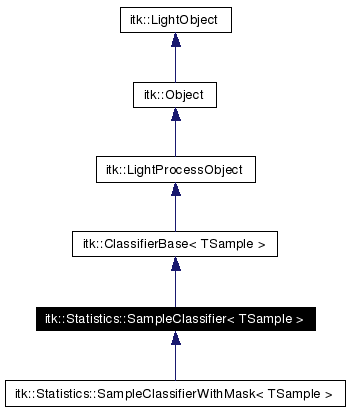
#include <itkSampleClassifier.h>
Inheritance diagram for itk::Statistics::SampleClassifier< TSample >:


[NOHEADER] | |
| virtual const char * | GetNameOfClass () const |
| Pointer | New () |
Public Types | |
| typedef SampleClassifier | Self |
| typedef ClassifierBase< TSample > | Superclass |
| typedef SmartPointer< Self > | Pointer |
| typedef SmartPointer< const Self > | ConstPointer |
| typedef MembershipSample< TSample > | OutputType |
| typedef TSample::MeasurementType | MeasurementType |
| typedef TSample::MeasurementVectorType | MeasurementVectorType |
| typedef Superclass::MembershipFunctionPointerVector | MembershipFunctionPointerVector |
| typedef unsigned int | ClassLabelType |
| typedef std::vector< ClassLabelType > | ClassLabelVectorType |
Public Member Functions | |
| void | SetSample (const TSample *sample) |
| const TSample * | GetSample () const |
| void | SetMembershipFunctionClassLabels (ClassLabelVectorType &labels) |
| ClassLabelVectorType & | GetMembershipFunctionClassLabels () |
| OutputType * | GetOutput () |
Protected Member Functions | |
| SampleClassifier () | |
| virtual | ~SampleClassifier () |
| void | PrintSelf (std::ostream &os, Indent indent) const |
| void | GenerateData () |
The first template argument is the type of the target sample data that this classifier will assign a class label for each measurement vector. The second one is the type of a membership value calculator for each. A membership calculator represents a specific knowledge about a class. In other words, it should tell us how "likely" is that a measurement vector (pattern) belong to the class. The third argument is the type of decision rule. The main role of a decision rule is comparing the return values of the membership calculators. However, decision rule can include some prior knowledge that can improve the result.
Before you call the GenerateData method to start the classification process, you should plug in all necessary parts ( one or more membership calculators, a decision rule, and a target sample data). To plug in the decision rule, you use SetDecisionRule method, for the target sample data, SetSample method, and for the membership calculators, use AddMembershipCalculator method.
As the method name indicates, you can have more than one membership calculator. One for each classes. The order you put the membership calculator becomes the class label for the class that is represented by the membership calculator.
The classification result is stored in a vector of Subsample object. Each class has its own class sample (Subsample object) that has InstanceIdentifiers for all measurement vectors belong to the class. The InstanceIdentifiers come from the target sample data. Therefore, the Subsample objects act as separate class masks.
Recent API changes: The static const macro to get the length of a measurement vector, MeasurementVectorSize has been removed to allow the length of a measurement vector to be specified at run time. Please use the function GetSample().GetMeasurementVectorSize() instead.
Definition at line 73 of file itkSampleClassifier.h.
|
|||||
|
Reimplemented in itk::Statistics::SampleClassifierWithMask< TSample, TMaskSample >. Definition at line 100 of file itkSampleClassifier.h. |
|
|||||
|
Reimplemented in itk::Statistics::SampleClassifierWithMask< TSample, TMaskSample >. Definition at line 101 of file itkSampleClassifier.h. Referenced by itk::Statistics::SampleClassifier< TSample >::~SampleClassifier(). |
|
|||||
|
Reimplemented from itk::LightProcessObject. Reimplemented in itk::Statistics::SampleClassifierWithMask< TSample, TMaskSample >. Definition at line 81 of file itkSampleClassifier.h. |
|
|||||
|
typedefs from TSample object Reimplemented in itk::Statistics::SampleClassifierWithMask< TSample, TMaskSample >. Definition at line 92 of file itkSampleClassifier.h. |
|
|||||
|
Sets the decision rule Reimplemented from itk::ClassifierBase< TSample >. Reimplemented in itk::Statistics::SampleClassifierWithMask< TSample, TMaskSample >. Definition at line 93 of file itkSampleClassifier.h. |
|
|||||
|
typedefs from Superclass Reimplemented from itk::ClassifierBase< TSample >. Reimplemented in itk::Statistics::SampleClassifierWithMask< TSample, TMaskSample >. Definition at line 98 of file itkSampleClassifier.h. |
|
|||||
|
Output type for GetClassSample method Reimplemented in itk::Statistics::SampleClassifierWithMask< TSample, TMaskSample >. Definition at line 89 of file itkSampleClassifier.h. |
|
|||||
|
Reimplemented from itk::LightProcessObject. Reimplemented in itk::Statistics::SampleClassifierWithMask< TSample, TMaskSample >. Definition at line 80 of file itkSampleClassifier.h. |
|
|||||
|
Standard class typedef Reimplemented from itk::ClassifierBase< TSample >. Reimplemented in itk::Statistics::SampleClassifierWithMask< TSample, TMaskSample >. Definition at line 78 of file itkSampleClassifier.h. |
|
|||||
|
Reimplemented from itk::ClassifierBase< TSample >. Reimplemented in itk::Statistics::SampleClassifierWithMask< TSample, TMaskSample >. Definition at line 79 of file itkSampleClassifier.h. |
|
|||||||||
|
|
|
|||||||||
|
Definition at line 124 of file itkSampleClassifier.h. References itk::Statistics::SampleClassifier< TSample >::ClassLabelVectorType. |
|
|||||||||
|
Starts the classification process Implements itk::ClassifierBase< TSample >. Reimplemented in itk::Statistics::SampleClassifierWithMask< TSample, TMaskSample >. |
|
|||||||||
|
Gets the user given class labels Definition at line 116 of file itkSampleClassifier.h. |
|
|||||||||
|
Standard macros Reimplemented from itk::ClassifierBase< TSample >. Reimplemented in itk::Statistics::SampleClassifierWithMask< TSample, TMaskSample >. |
|
|||||||||
|
Returns the classification result |
|
|||||||||
|
Returns the target data |
|
|||||||||
|
Standard macros Reimplemented from itk::LightProcessObject. Reimplemented in itk::Statistics::SampleClassifierWithMask< TSample, TMaskSample >. |
|
||||||||||||||||
|
Methods invoked by Print() to print information about the object including superclasses. Typically not called by the user (use Print() instead) but used in the hierarchical print process to combine the output of several classes. Reimplemented from itk::ClassifierBase< TSample >. Reimplemented in itk::Statistics::SampleClassifierWithMask< TSample, TMaskSample >. |
|
||||||||||
|
Sets the user given class labels for membership functions. If users do not provide class labels for membership functions by calling this function, then the index of the membership function vector for a membership function will be used as class label of measurement vectors belong to the membership function |
|
||||||||||
|
Sets the target data that will be classified by this |
 1.3.5 written by Dimitri van Heesch,
© 1997-2000
1.3.5 written by Dimitri van Heesch,
© 1997-2000